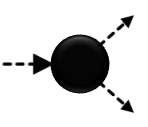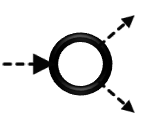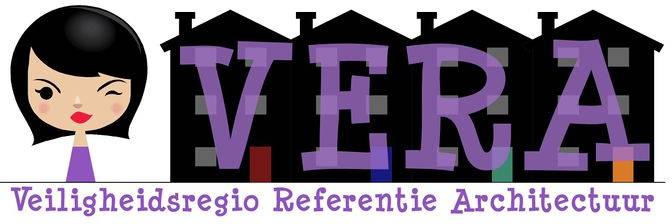DisplayArchiMateGlossary
ArchiMate begrippenlijst 3.1
| Rationale-elementen | ||
|---|---|---|
| Assessment |  | An assessment represents the result of an analysis of the state of affairs of the enterprise with respect to some driver. |
| Constraint |  | A constraint represents a factor that prevents or obstructs the realization of goals. |
| Driver |  | A driver represents an external or internal condition that motivates an organization to define its goals and implement the changes necessary to achieve them. |
| Goal |  | A goal represents a high-level statement of intent, direction, or desired end state for an organization and its stakeholders. |
| Meaning |  | Meaning represents the knowledge or expertise present in, or the interpretation given to, a core element in a particular context. |
| Outcome |  | An outcome represents an end result that has been achieved. |
| Principle |  | A principle represents a qualitative statement of intent that should be met by the architecture. |
| Requirement |  | A requirement represents a statement of need that must be met by the architecture. |
| Stakeholder |  | A stakeholder is the role of an individual, team, or organization (or classes thereof) that represents their interests in the outcome of the architecture. |
| Value |  | Value represents the relative worth, utility, or importance of a core element or an outcome. |
| Strategie-elementen | ||
| Capability |  | A capability represents an ability that an active structure element, such as an organization, person, or system, possesses. |
| CourseOfAction |  | A course of action is an approach or plan for configuring some capabilities and resources of the enterprise, undertaken to achieve a goal. |
| Resource |  | A resource represents an asset owned or controlled by an individual or organization. |
| ValueStream |  | A value stream represents a sequence of activities that create an overall result for a customer, stakeholder, or end user. |
| Bedrijfslaag | ||
| BusinessActor |  | A business actor is a business entity that is capable of performing behavior. |
| BusinessCollaboration |  | A business collaboration is an aggregate of two or more business internal active structure elements that work together to perform collective behavior. |
| BusinessEvent |  | A business event is a business behavior element that denotes an organizational state change. It may originate from and be resolved inside or outside the organization. |
| BusinessFunction |  | A business function is a collection of business behavior based on a chosen set of criteria (typically required business resources and/or competencies), closely aligned to an organization, but not necessarily explicitly governed by the organization. |
| BusinessInteraction |  | A business interaction is a unit of collective business behavior performed by (a collaboration of) two or more business roles. |
| BusinessInterface |  | A business interface is a point of access where a business service is made available to the environment. |
| BusinessObject |  | A business object represents a concept used within a particular business domain. |
| BusinessProcess |  | A business process represents a sequence of business behaviors that achieves a specific outcome such as a defined set of products or business services. |
| BusinessRole |  | A business role is the responsibility for performing specific behavior, to which an actor can be assigned, or the part an actor plays in a particular action or event. |
| BusinessService |  | A business service represents an explicitly defined exposed business behavior. |
| Contract |  | A contract represents a formal or informal specification of an agreement between a provider and a consumer that specifies the rights and obligations associated with a product and establishes functional and non-functional parameters for interaction. |
| Product |  | A product represents a coherent collection of services and/or passive structure elements, accompanied by a contract/set of agreements, which is offered as a whole to (internal or external) customers. |
| Representation |  | A representation represents a perceptible form of the information carried by a business object. |
| Applicatielaag | ||
| ApplicationCollaboration |  | An application collaboration represents an aggregate of two or more application components that work together to perform collective application behavior. |
| ApplicationComponent |  | An application component represents an encapsulation of application functionality aligned to implementation structure, which is modular and replaceable. It encapsulates its behavior and data, exposes services, and makes them available through interfaces. |
| ApplicationEvent |  | An application event is an application behavior element that denotes a state change. |
| ApplicationFunction |  | An application function represents automated behavior that can be performed by an application component. |
| ApplicationInteraction |  | An application interaction represents a unit of collective application behavior performed by (a collaboration of) two or more application components. |
| ApplicationInterface |  | An application interface represents a point of access where application services are made available to a user, another application component, or a node. |
| ApplicationProcess |  | An application process represents a sequence of application behaviors that achieves a specific outcome. |
| ApplicationService |  | An application service represents an explicitly defined exposed application behavior. |
| DataObject |  | A data object represents data structured for automated processing. |
| Technologielaag | ||
| Artifact |  | An artifact represents a piece of data that is used or produced in a software development process, or by deployment and operation of an IT system. |
| CommunicationNetwork |  | A communication network represents a set of structures that connects computer systems or other electronic devices for transmission, routing, and reception of data or data-based communications such as voice and video. |
| Device |  | A device is a physical IT resource upon which system software and artifacts may be stored or deployed for execution. |
| Node |  | A node represents a computational or physical resource that hosts, manipulates, or interacts with other computational or physical resources. |
| Path |  | A path represents a link between two or more nodes, through which these nodes can exchange data or material. |
| SystemSoftware |  | System software represents software that provides or contributes to an environment for storing, executing, and using software or data deployed within it. |
| TechnologyCollaboration |  | A technology collaboration represents an aggregate of two or more nodes that work together to perform collective technology behavior. |
| TechnologyEvent |  | A technology event is a technology behavior element that denotes a state change. |
| TechnologyFunction |  | A technology function represents a collection of technology behavior that can be performed by a node. |
| TechnologyInteraction |  | A technology interaction represents a unit of collective technology behavior performed by (a collaboration of) two or more nodes. |
| TechnologyInterface |  | A technology interface represents a point of access where technology services offered by a node can be accessed. |
| TechnologyObject |  | A technology object represents a passive element that is used or produced by technology behavior. |
| TechnologyProcess |  | A technology process represents a sequence of technology behaviors that achieves a specific outcome. |
| TechnologyService |  | A technology service represents an explicitly defined exposed technology behavior. |
| Fysieke elementen | ||
| DistributionNetwork |  | A distribution network represents a physical network used to transport materials or energy. |
| Equipment |  | Equipment represents one or more physical machines, tools, or instruments that can create, use, store, move, or transform materials. |
| Facility |  | A facility represents a physical structure or environment. |
| Material |  | Material represents tangible physical matter or physical elements. |
| Implementatie- en migratie-elementen | ||
| Deliverable |  | A deliverable represents a precisely-defined outcome of a work package. |
| Gap |  | A gap represents a statement of difference between two plateaus. |
| ImplementationEvent |  | An implementation event is a behavior element that denotes a state change related to implementation or migration. |
| Plateau |  | A plateau represents a relatively stable state of the architecture that exists during a limited period of time. |
| WorkPackage |  | A work package represents a series of actions identified and designed to achieve specific results within specified time and resource constraints. |
| Samengestelde elementen | ||
| Location |  | A location is a place or position where structure elements can be located or behavior can be performed. |
| Grouping | The grouping element aggregates or composes concepts that belong together based on some common characteristic. | |
| Structuurrelaties | ||
| AggregationRelationship |  | The aggregation relationship indicates that an element consists of one or more other concepts. |
| AssignmentRelationship |  | The assignment relationship expresses the allocation of responsibility, performance of behavior, or execution. |
| CompositionRelationship |  | The composition relationship indicates that an element consists of one or more other concepts. |
| RealizationRelationship |  | The realization relationship indicates that an entity plays a critical role in the creation, achievement, sustenance, or operation of a more abstract entity. |
| Afhankelijkheidsrelaties | ||
| AccessRelationship |  | The access relationship models the ability of behavior and active structure elements to observe or act upon passive structure elements. |
| InfluenceRelationship |  | The influence relationship models that an element affects the implementation or achievement of some motivation element. |
| ServingRelationship |  | The serving relationship models that an element provides its functionality to another element. |
| Dynamische relaties | ||
| FlowRelationship |  | The flow relationship represents transfer from one element to another. |
| TriggeringRelationship |  | The triggering relationship describes a temporal or causal relationship between elements. |
| Overige relaties | ||
| AssociationRelationship |  | An association relationship models an unspecified relationship, or one that is not represented by another ArchiMate relationship. |
| SpecializationRelationship |  | The specialization relationship indicates that an element is a particular kind of another element. |
| Relatieconnectoren | ||
| AndJunction |  | An and-junction is used to explicitly express that several elements together participate in the relationship. |
| OrJunction |  | An or-junction is used to explicitly express that one of the elements participates in the relationship. |
De definities op deze pagina zijn overgenomen uit de ArchiMate-specificatie van The Open Group. Deze specificatie is hier te vinden.
